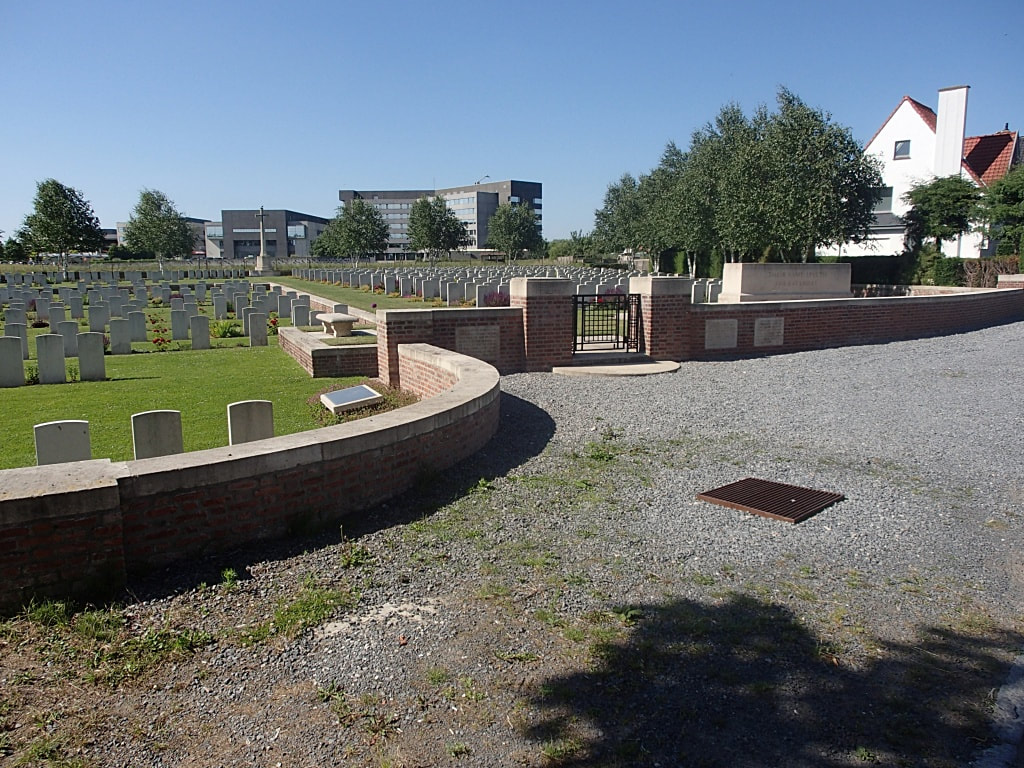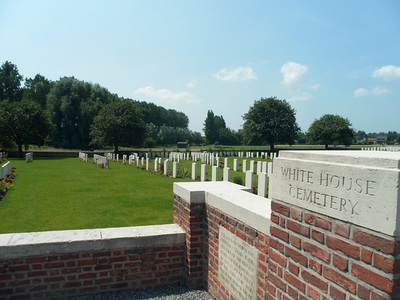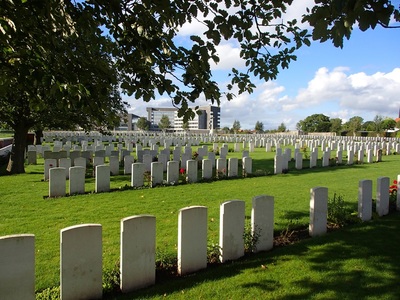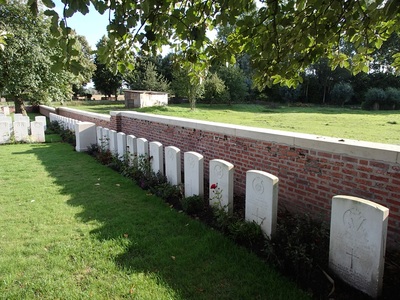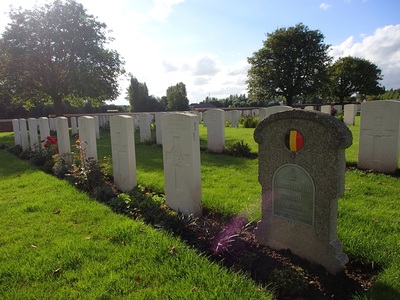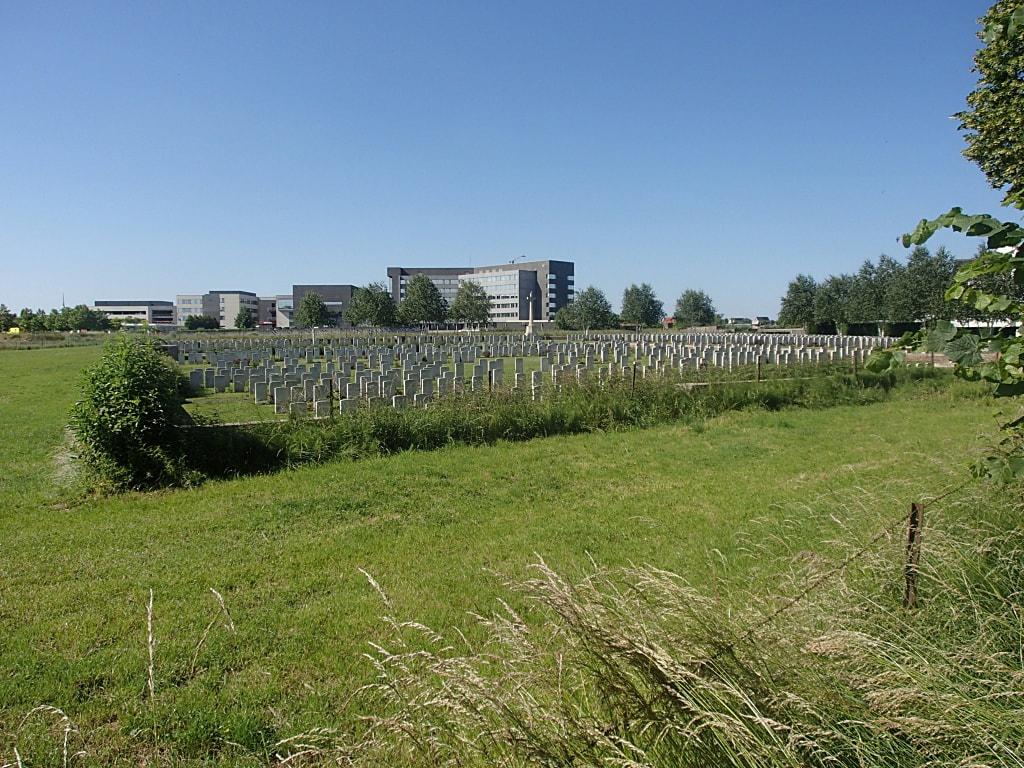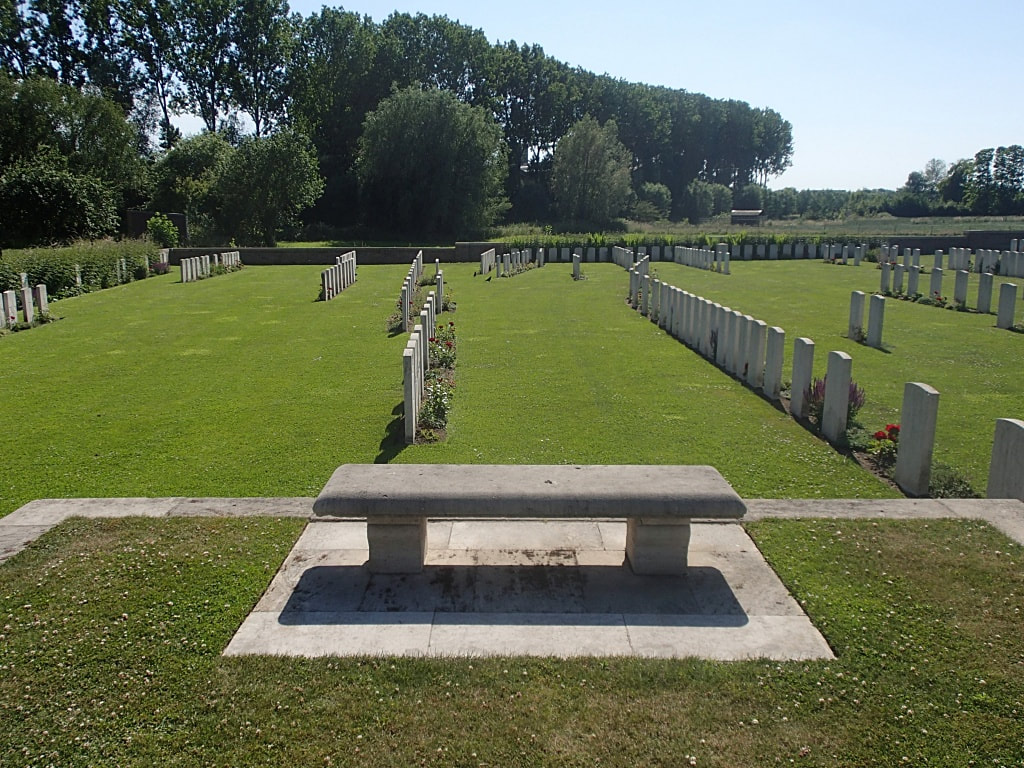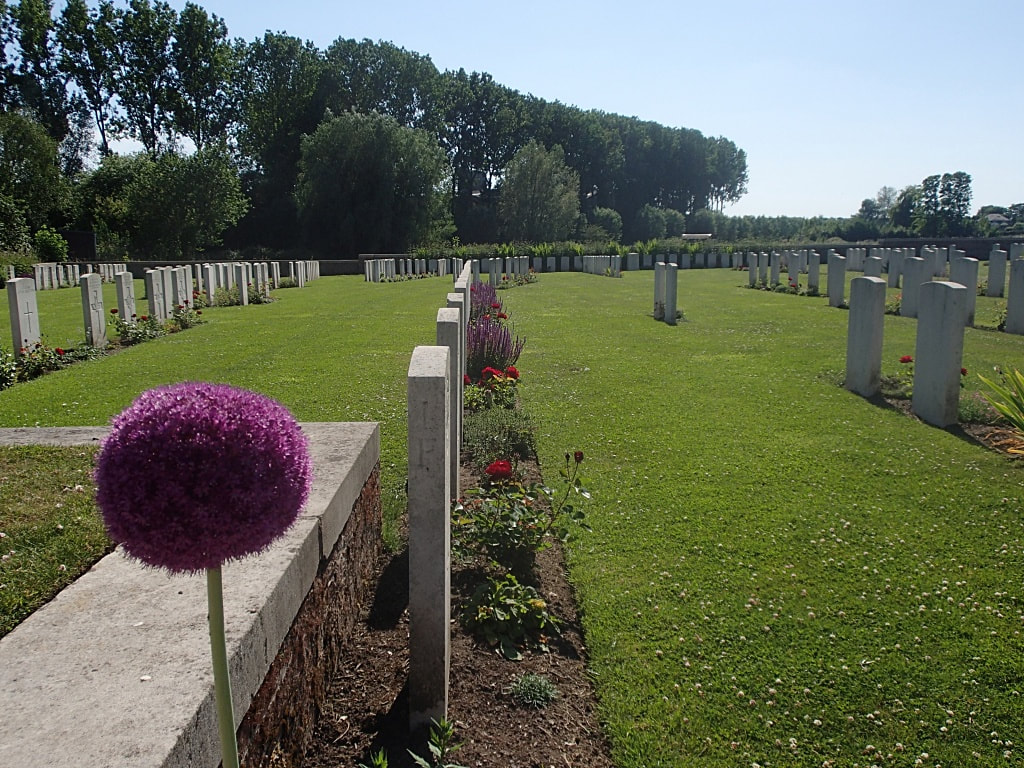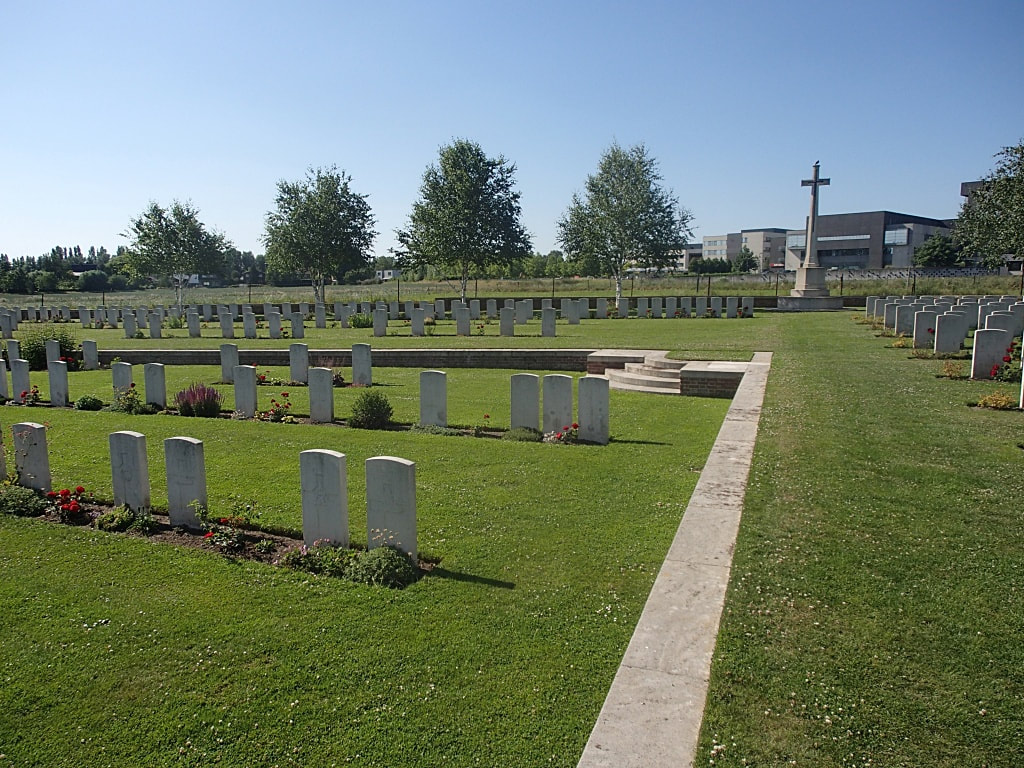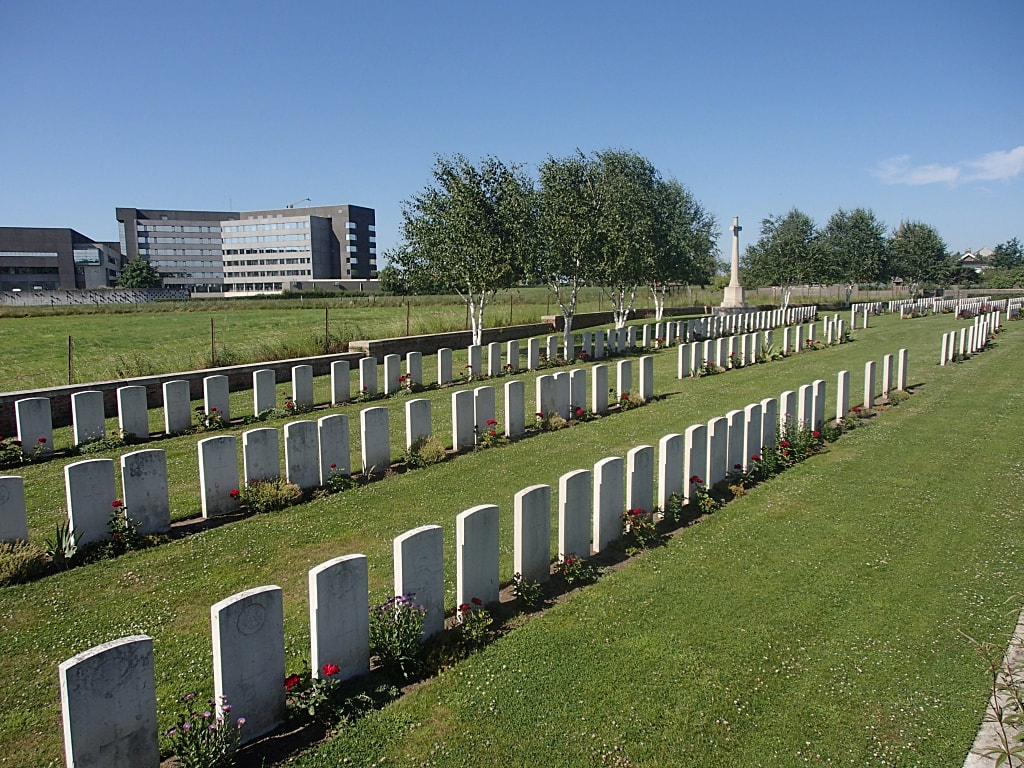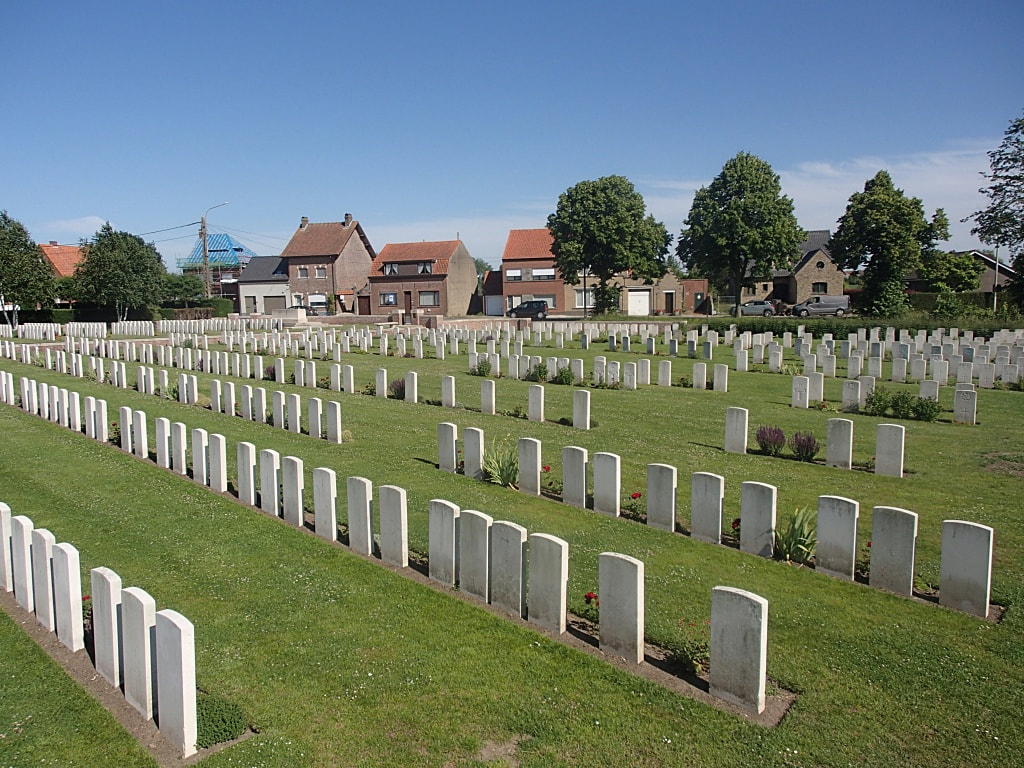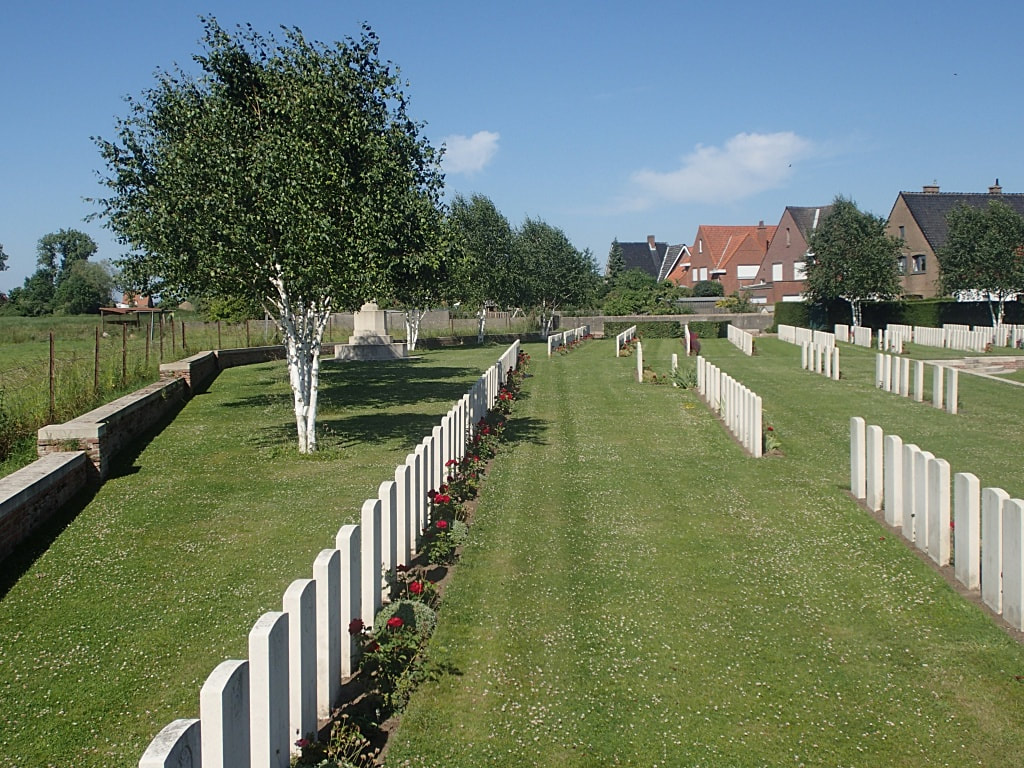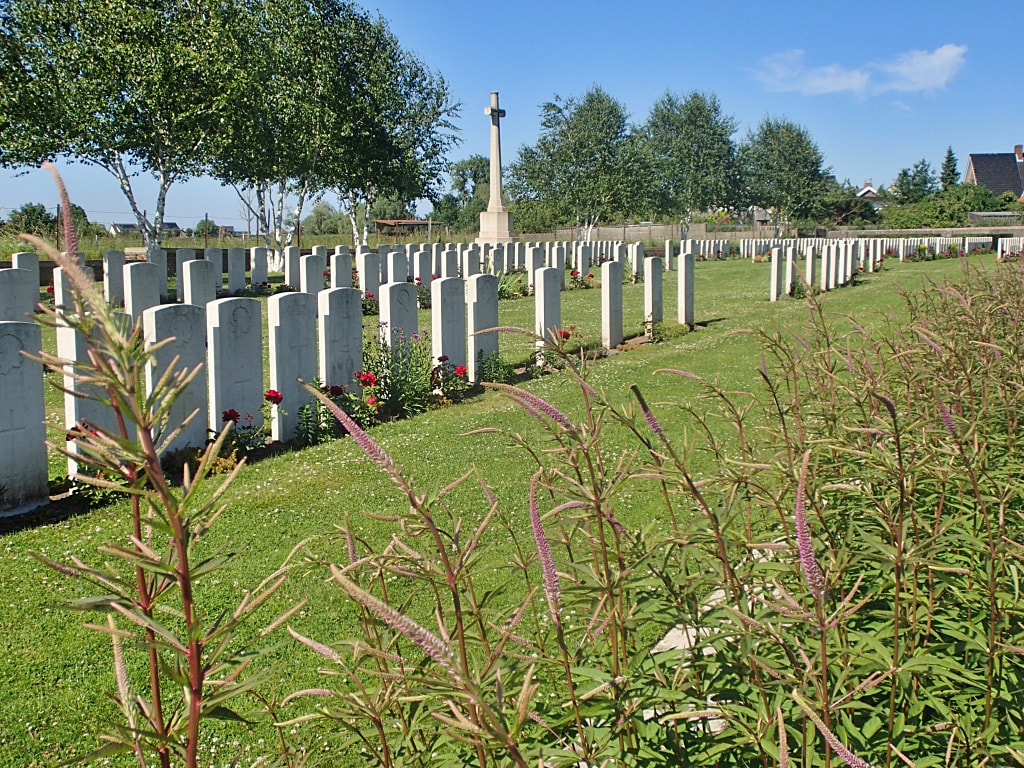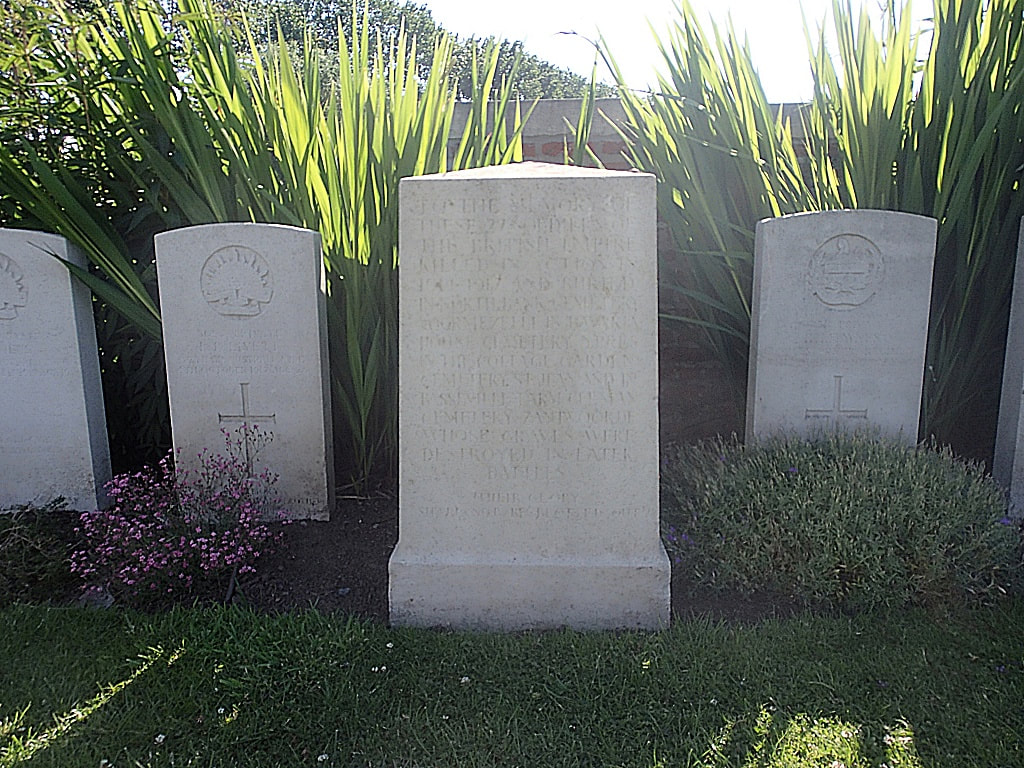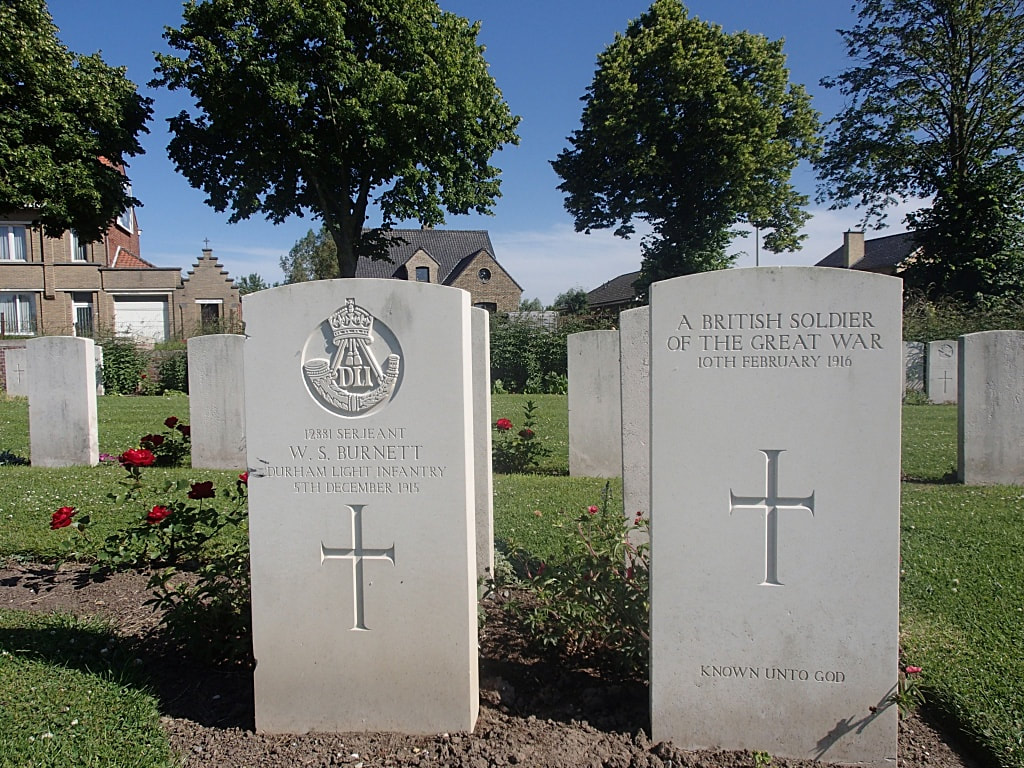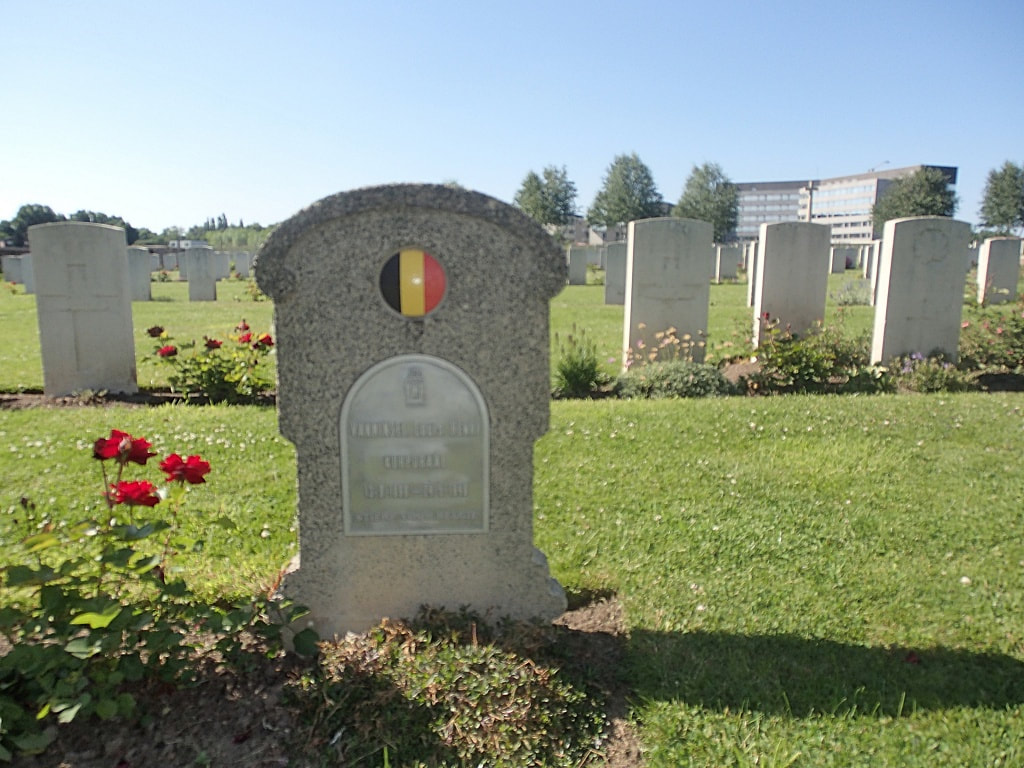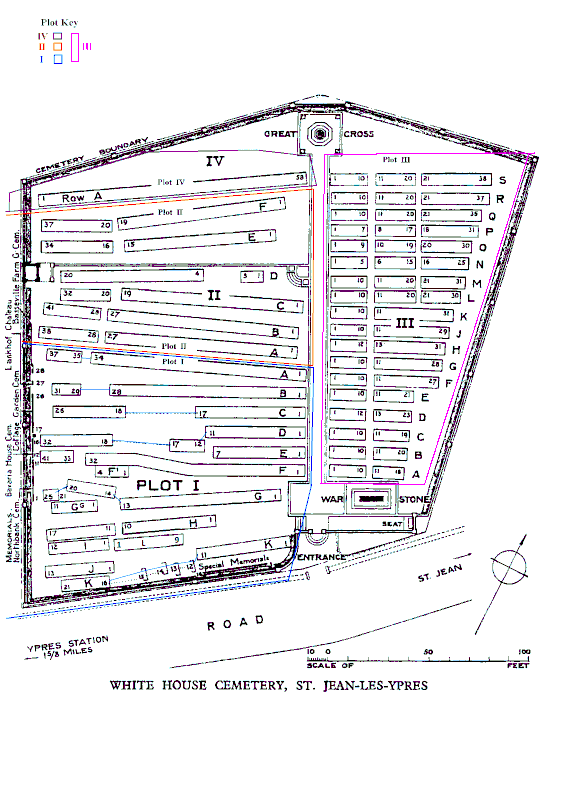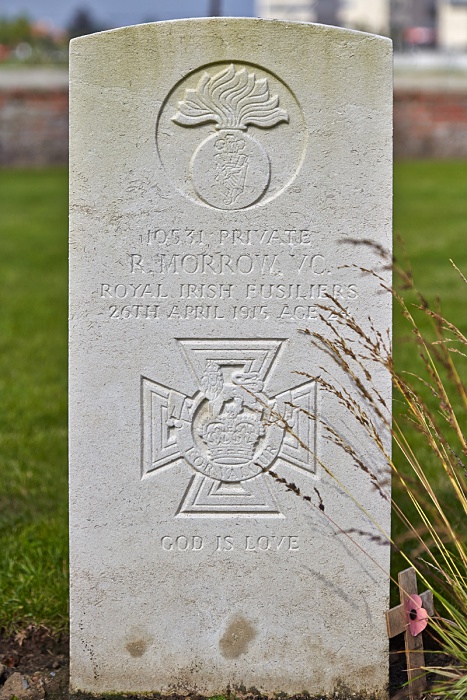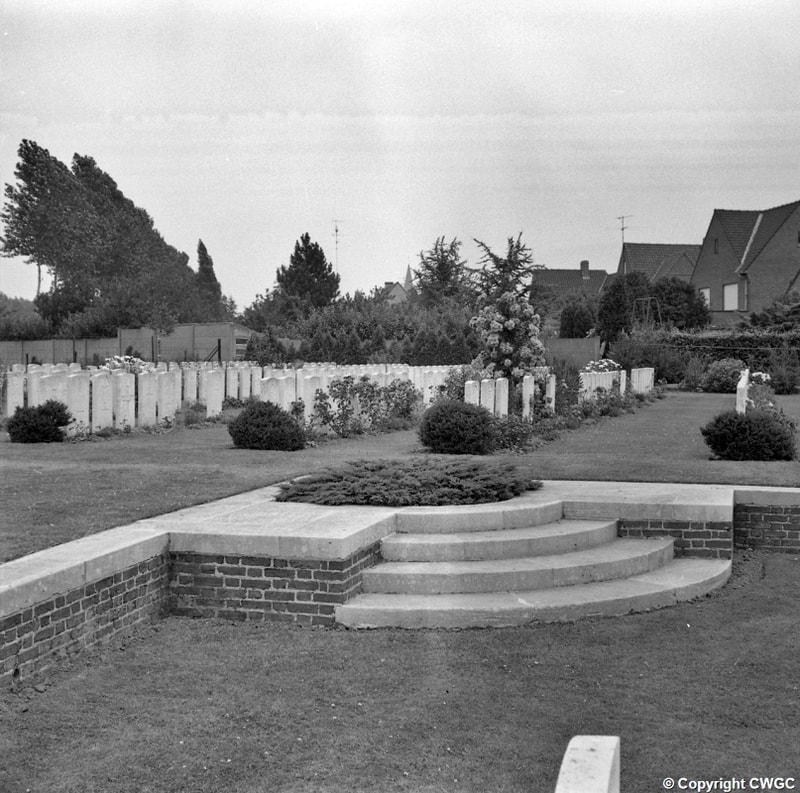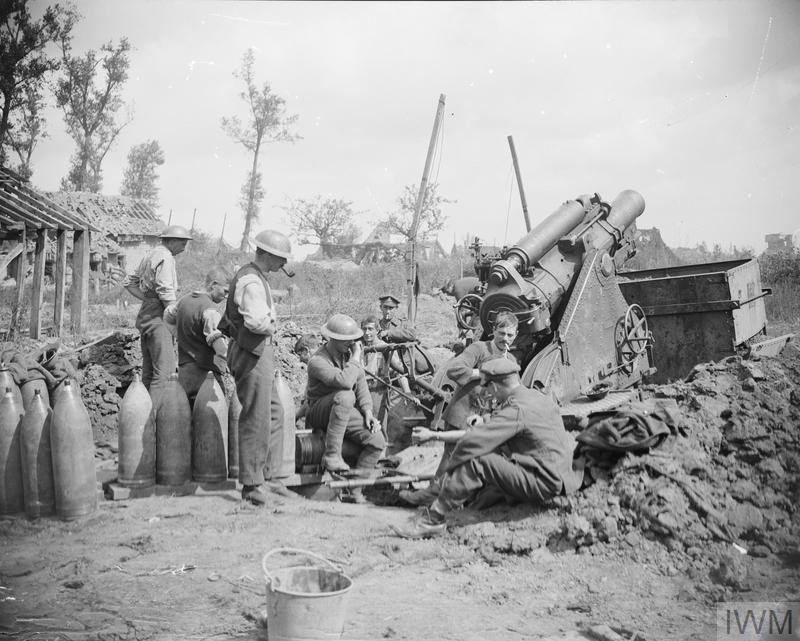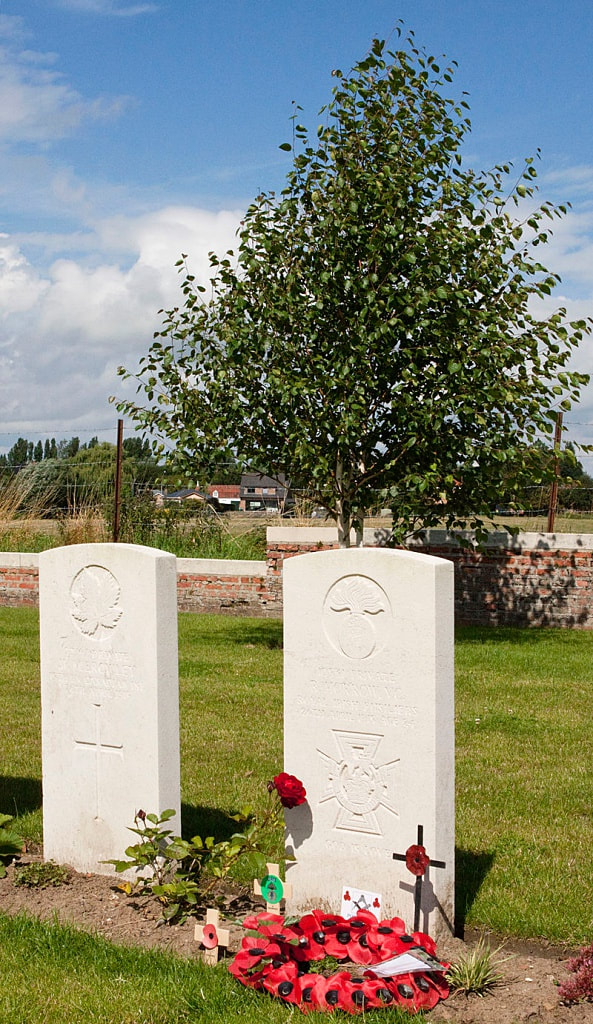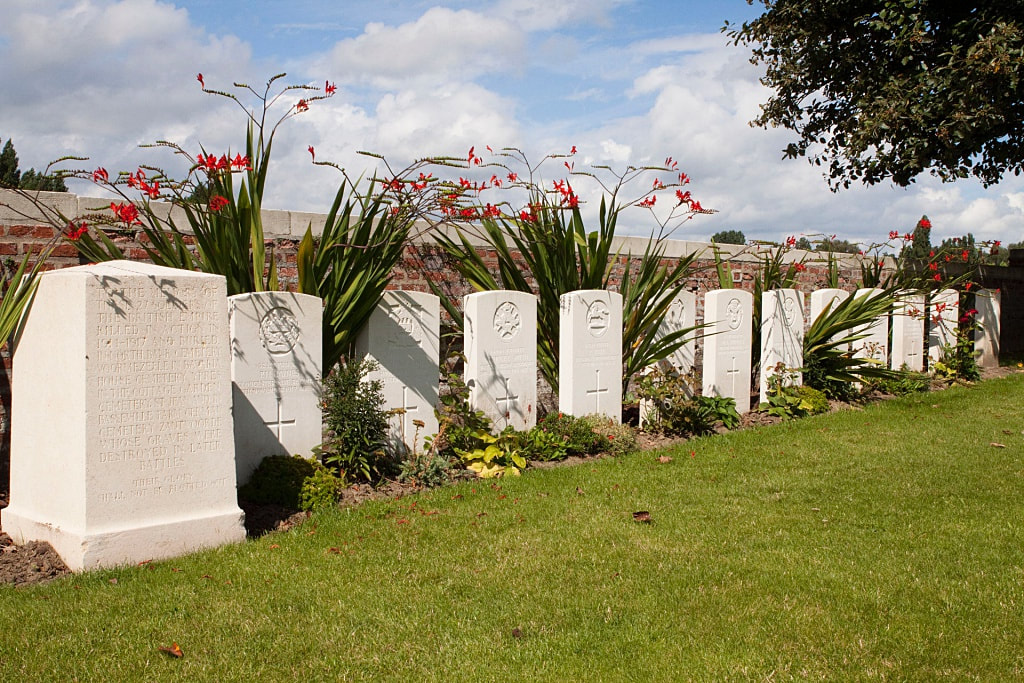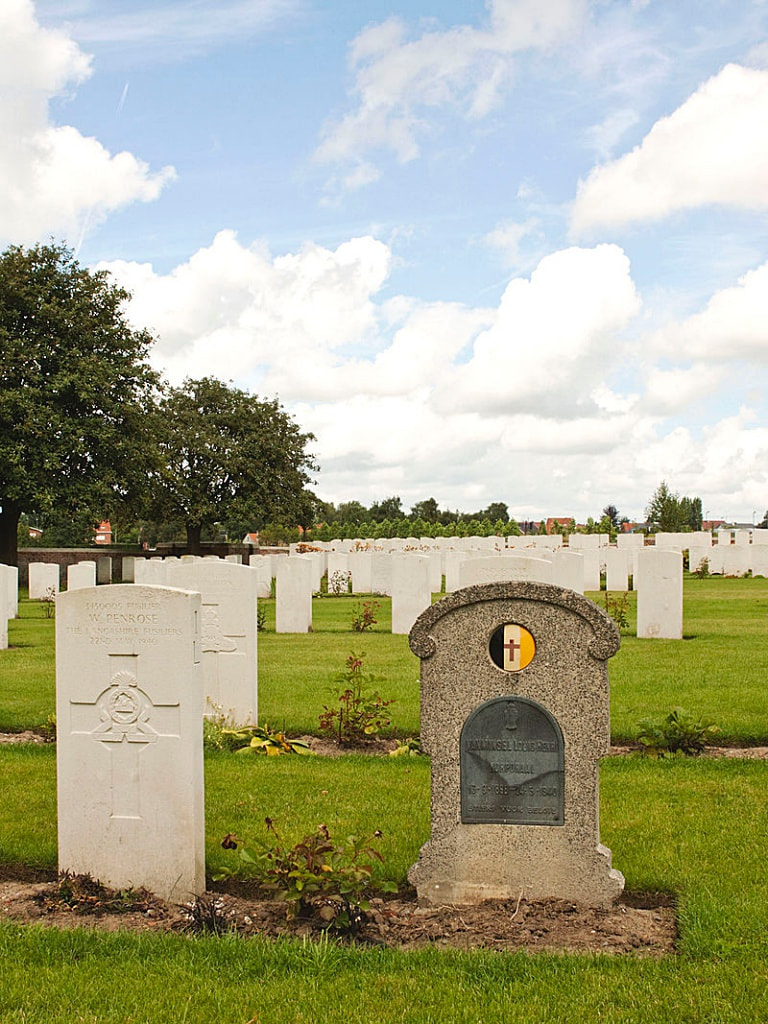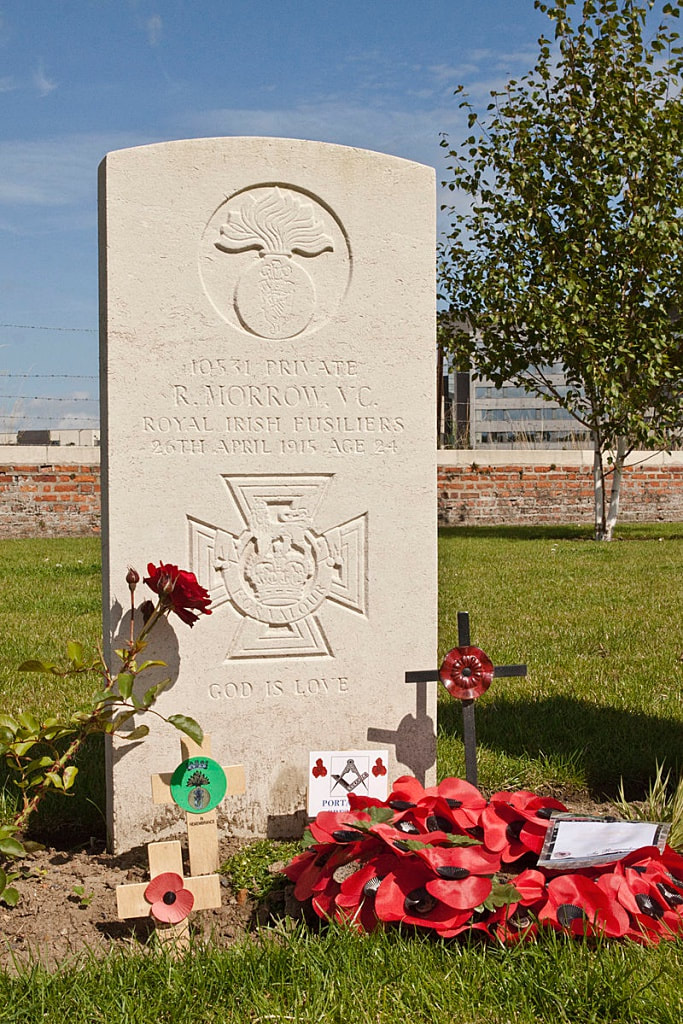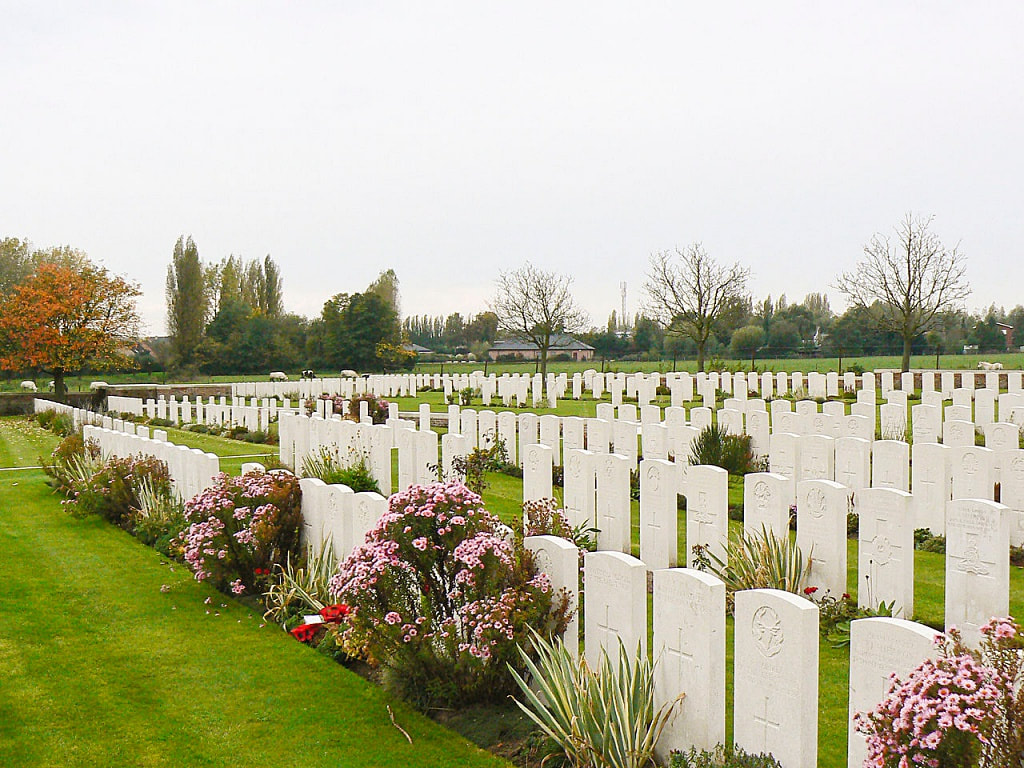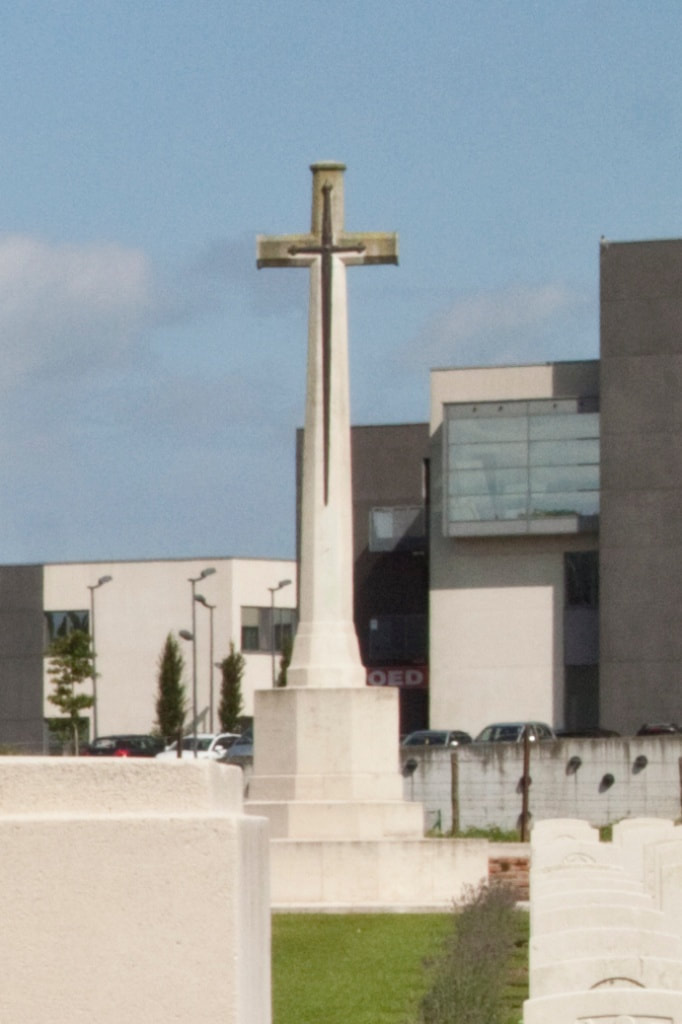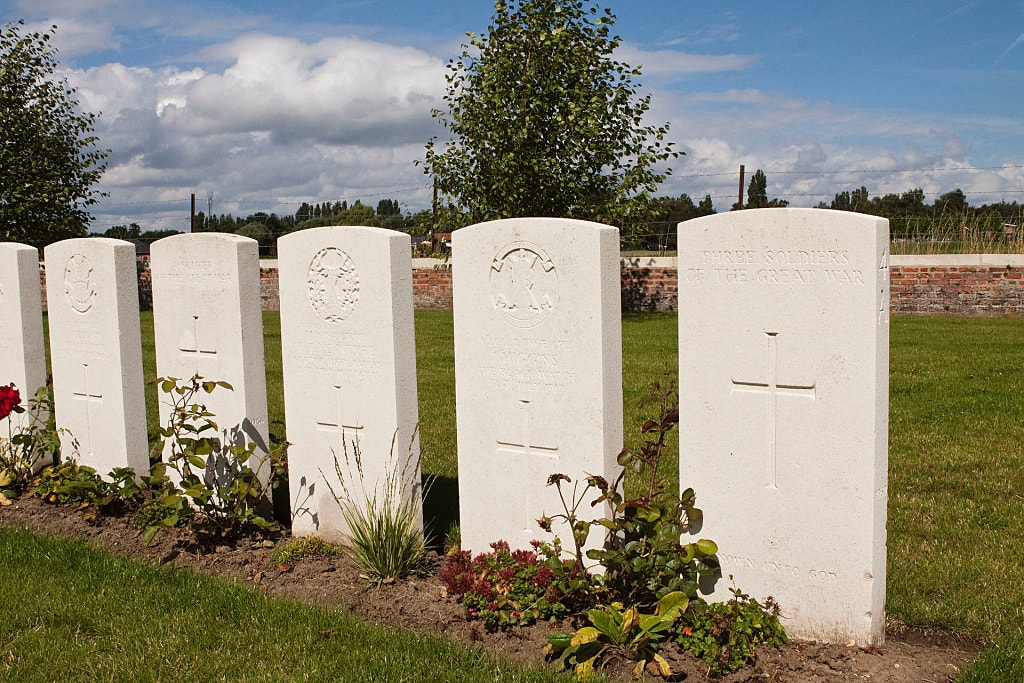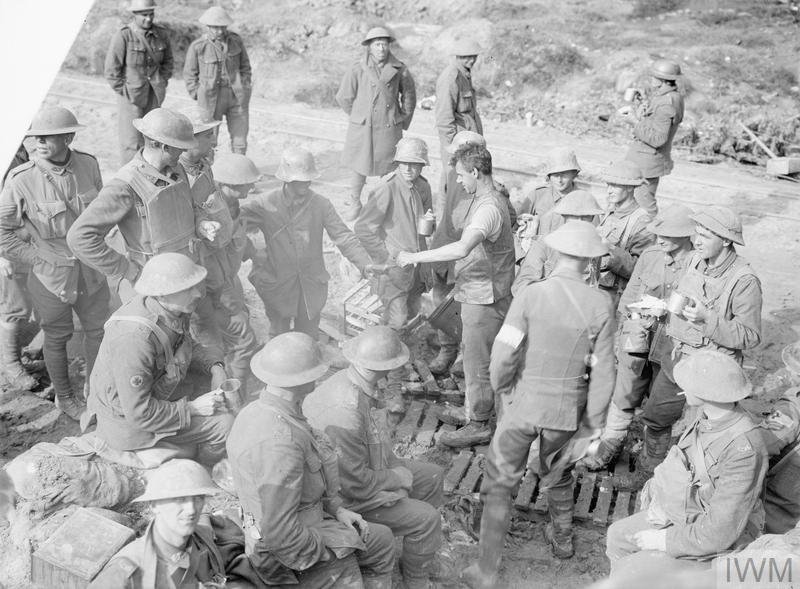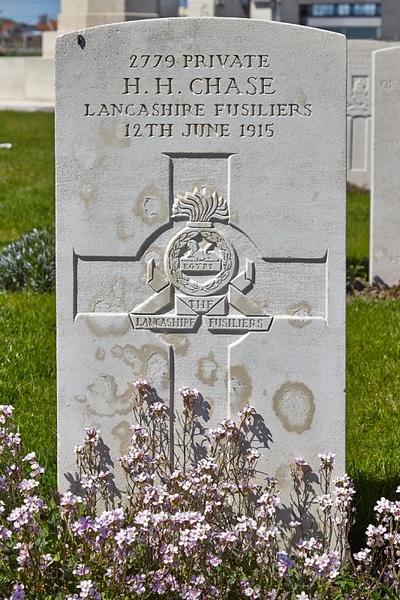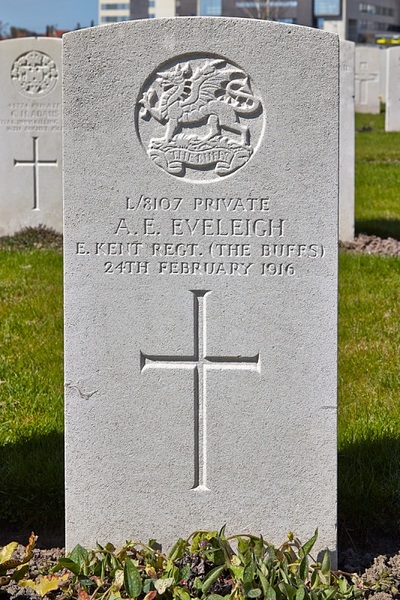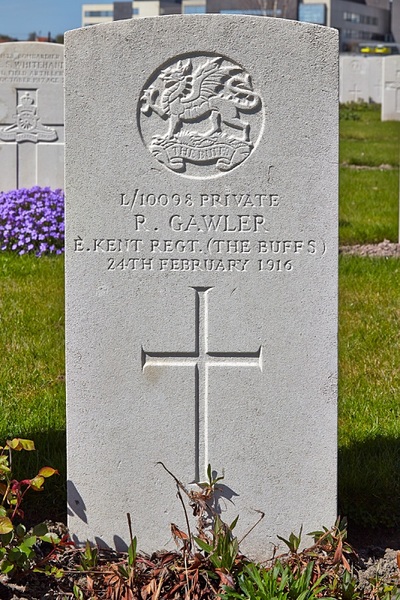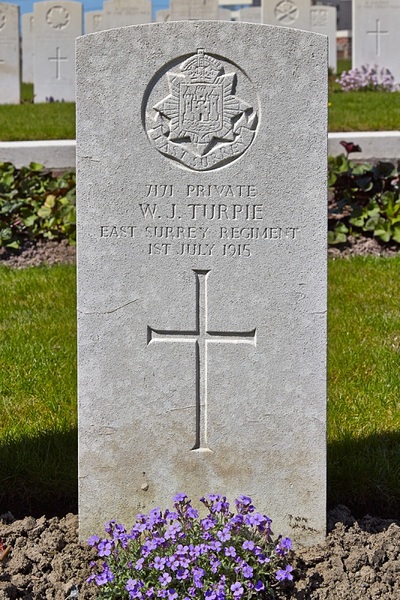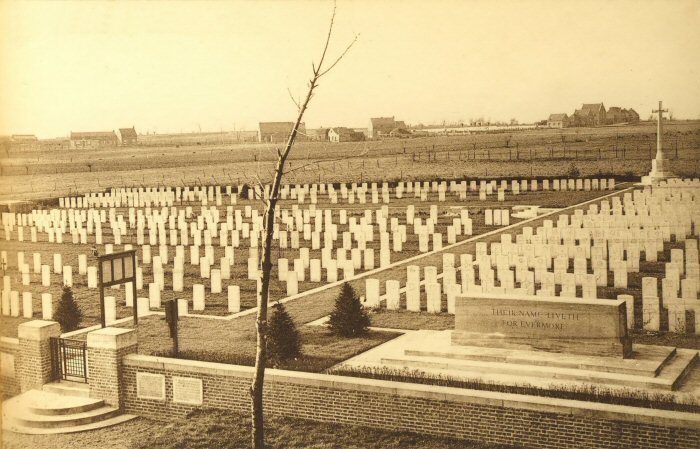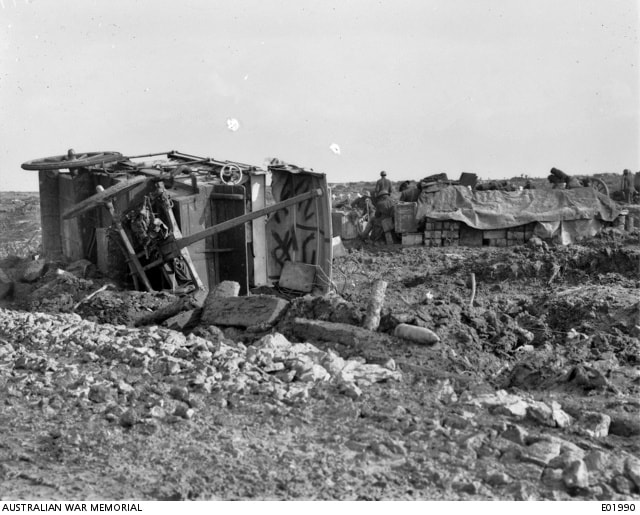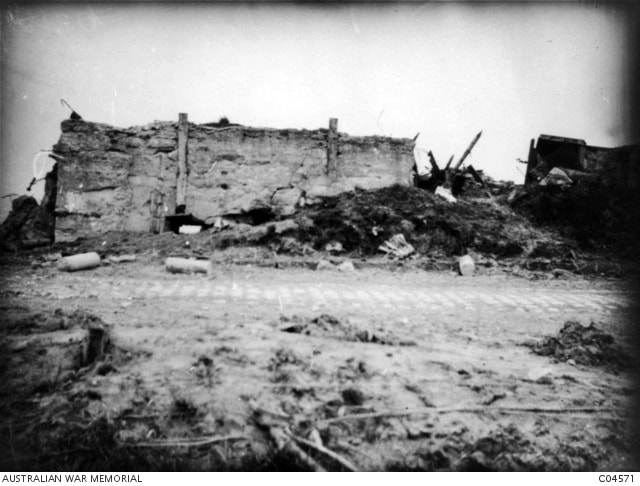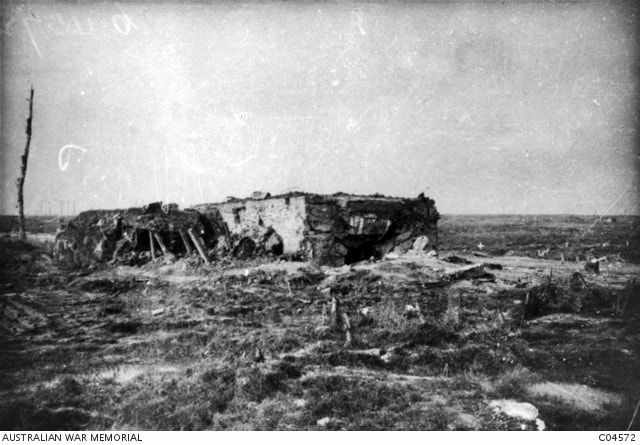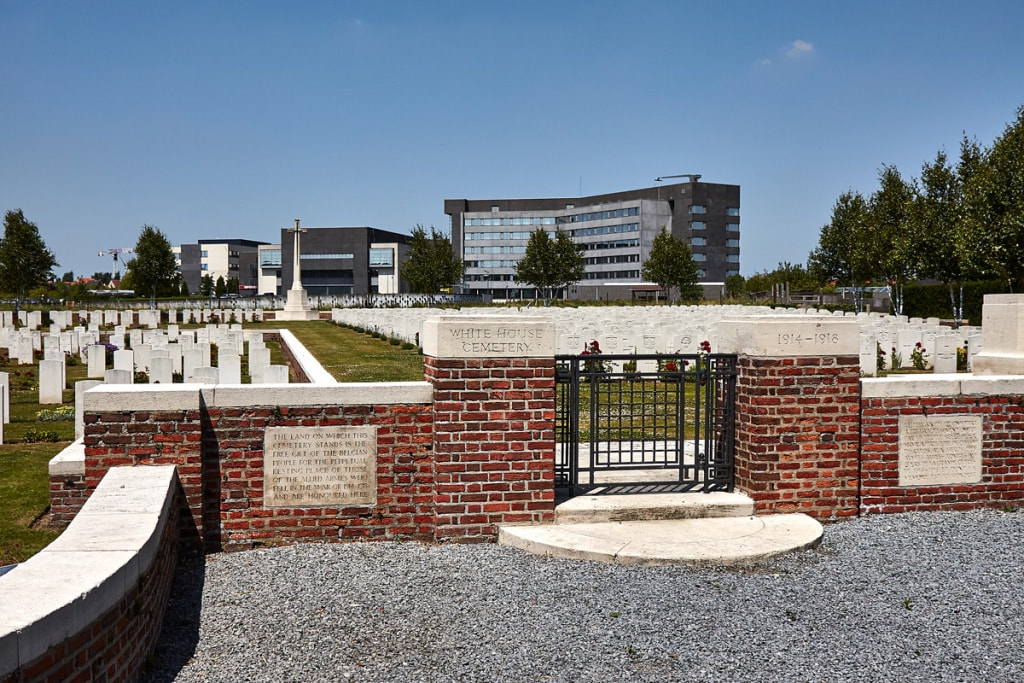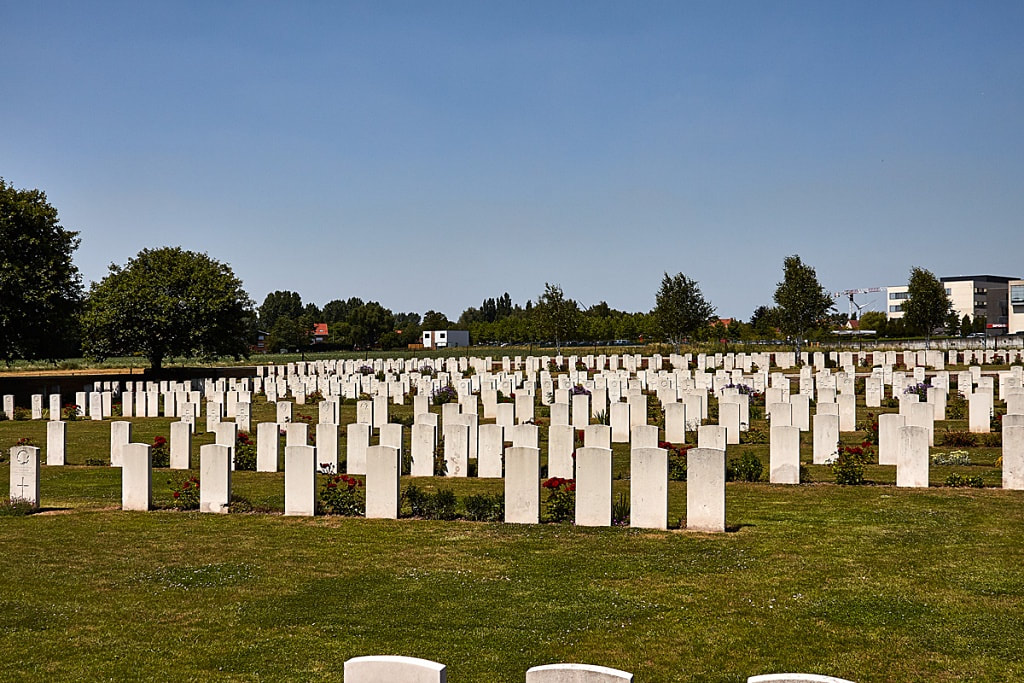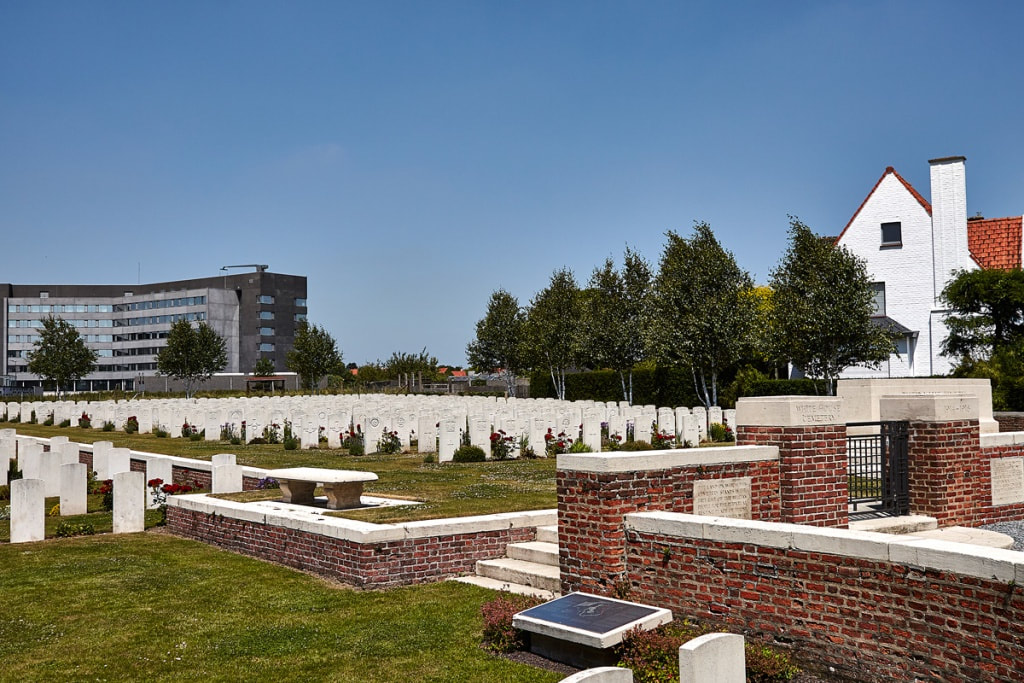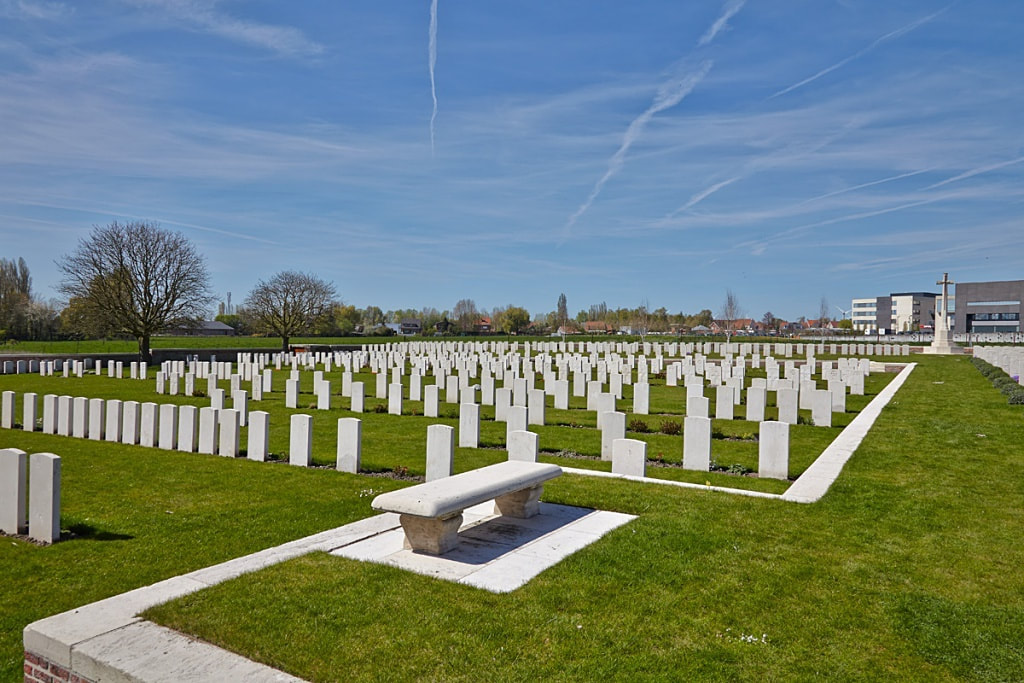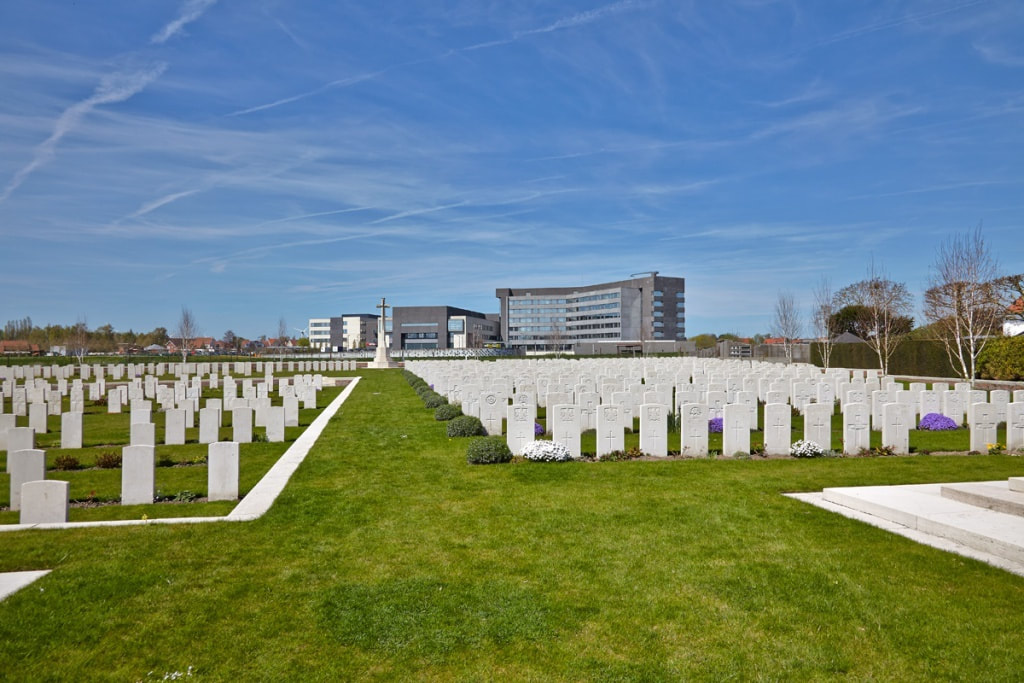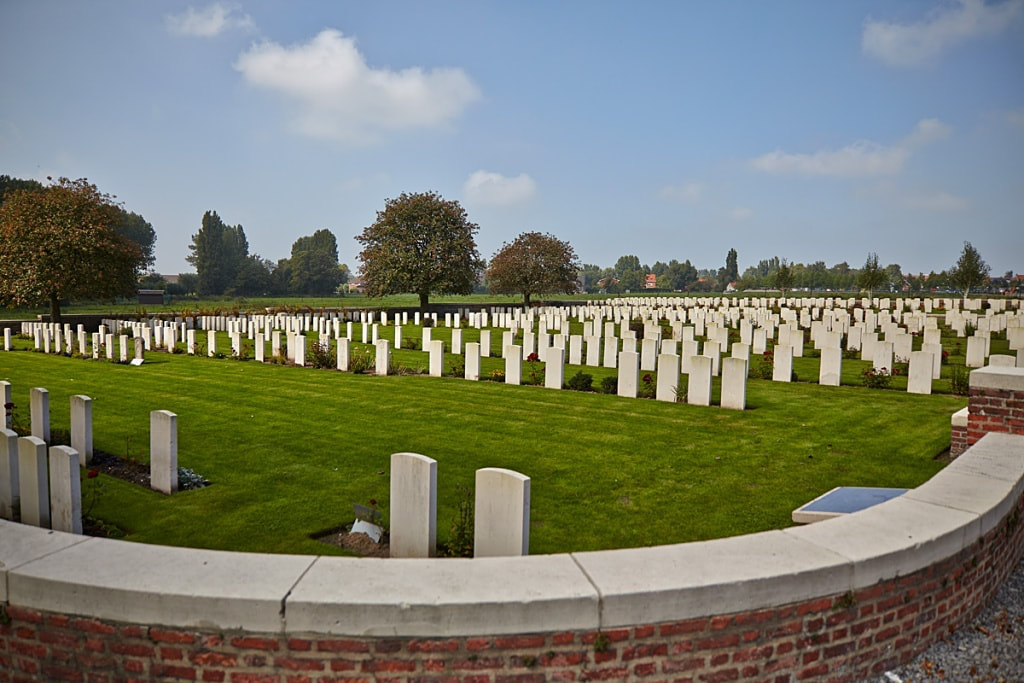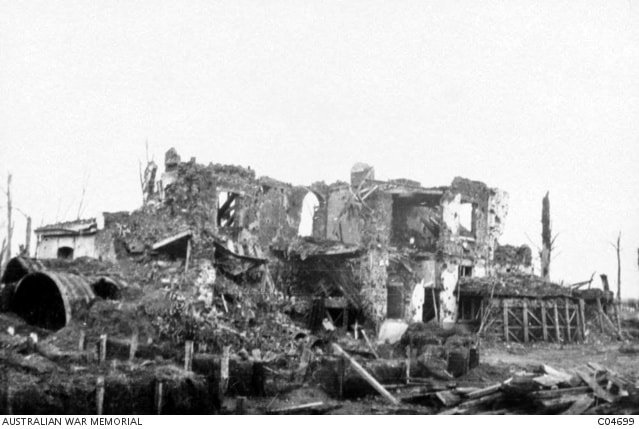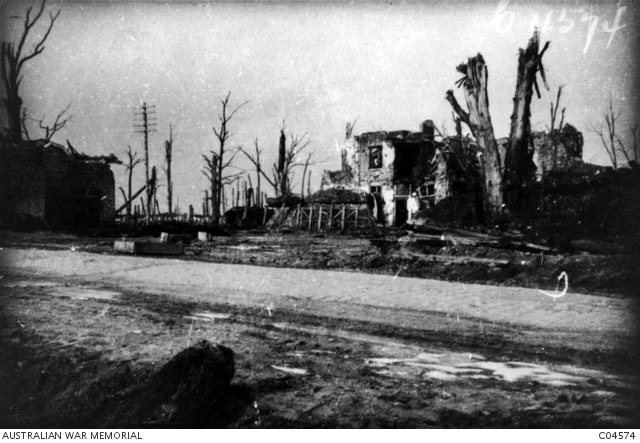WHITE HOUSE CEMETERY
St. Jean-les-Ypres
West-Vlaanderen
Belgium
GPS Coordinates: Latitude: 50.86172 Longitude: 2.89923
Location Information
The Cemetery is located north-east of Ieper on the Brugseweg (N313) in the direction of Roeselare/Brugge.
From the Grote Markt in Ieper take the road called Korte Torhoutstraat and at the end turn left into Lange Torhoutstraat, follow this road over the roundabout into Kalfvart and continue to the traffic lights. At the traffic lights turn right into Brugseweg and the cemetery is along here on the left before the village of St.Jan.
Visiting Information
Wheelchair access is possible via the main entrance.
Historical Information
White House Cemetery was begun in March 1915 and used until April 1918 by units holding this part of the line. It then comprised most of the present Plots I and II; but after the Armistice these Plots were completed, and III and IV added, when graves were brought in from the battlefields around Ypres (now Ieper) and from a number of small burial grounds, including the following:-
BASSEVILLE FARM GERMAN CEMETERY, ZANTVOORDE, on the Zantvoorde-Zillebeke road, where five soldiers from the United Kingdom were buried in November, 1914.
BAVARIA HOUSE CEMETERY, YPRES, at an Advanced Dressing Station near Verlorenhoek and close to the Potijze-Zonnebeke road. Here were buried, in September-November, 1917, 17 soldiers from the United Kingdom, four from Canada, four from Australia, three from New Zealand and one from the West Indies.
BEDFORD HOUSE CEMETERY, ENCLOSURE No.1, ZILLEBEKE, on the East side of the Ypres-St. Eloi road. In this, the oldest of the five Bedford House "Enclosures," ten French soldiers were buried in 1914 and 1915, and 14 soldiers from the United Kingdom in 1915 and 1917.
COTTAGE GARDEN CEMETERY, ST. JEAN, close to the main street of the village. Here were buried, in 1914-1915, 44 soldiers from the United Kingdom and one from Canada.
GREEN HUNTER CEMETERY, VLAMERTINGHE, close to the cabaret "In den Groenen Jager," a little West of the Vlamertinghe-Voormezeele road. Twenty soldiers from the United Kingdom were buried here in 1915 and 1918.
HENGEBAERT FARM CEMETERY, DICKEBUSCH, 600 metres North of Dickebusch village, where 16 soldiers from Australia and ten (all R.F.A.) from the United Kingdom were buried in 1915-1917.
NORTH BANK CEMETERY, VOORMEZEELE, (also called Lankhof Cemetery), between Lankhof Farm and the canal. In this cemetery, which was completely destroyed, eleven Canadian soldiers were buried in April and May, 1916.
WILDE WOOD CEMETERY, ZONNEBEKE, a little North of the Ypres-Roulers railway line, where 17 soldiers from the United Kingdom were buried in July-September, 1917.
There are now 1,163 Commonwealth servicemen of the First World War buried or commemorated in this cemetery. 322 of the burials are unidentified but there are special memorials to 16 casualties known or believed to be buried among them. Other special memorials record the names of 28 casualties who were buried in other cemeteries, but whose graves could not be found on concentration. The cemetery also contains eight Second World War burials, all dating from May 1940.
Total Burials: 1,172.
World War One Identified Casualties: United Kingdom 705, Canada 71, Australia 38, New Zealand 24, South Africa 2, India 1. Total 841.
World War One Unidentified Casualties: 322.
World War Two Identified Casualties: United Kingdom 8, Belgium 1. Total 9.
The cemetery was designed by Sir Reginald Blomfield and Captain Wilfred Clement Von Berg, M. C.
10531 Private Robert Morrow, V. C.
1st Battalion Royal Irish Fusiliers
26th April 1915, aged 24.
Plot IV. A. 44.
Son of Hugh and Margaret Jane Morrow, of Sessia, Newmills, Dungannon, Co. Tyrone.
His headstone bears the inscription "God Is Love"
Citation:
An extract from "The London Gazette", No. 29170, dated 22nd May, 1915, records the following:- "For most conspicuous bravery near Messines on 12th April, 1915, when he rescued and carried successively to places of comparative safety, several men who had been buried in the debris of trenches wrecked by shell fire. Private Morrow carried out this gallant work on his own initiative and under very heavy fire from the enemy."
Headstone
Images of the cemetery from March 1957.
Images in this gallery © Werner Van Caneghem

4092 Lance Corporal
Albert Decker
22nd Bn. Australian Infantry, A. I. F.
9th October 1917, aged 20.
Plot III. H. 26.
Son of Jacob Elliot Decker and Emily Decker, of Church St., Warragul, Victoria, Australia.
A 19 year old labourer prior to enlisting on 23 December 1915, he embarked for overseas with the 10th Reinforcements from Melbourne on 7 March 1916 aboard HMAT Wiltshire (A18). Following further training in Egypt, he proceeded to France where he joined the 22nd Battalion on 31 July 1916. After being wounded in action near Pozieres on 6 August, he was evacuated to England for medical treatment and then returned to his battalion on 24 November 1916. He was promoted to Lance Corporal (L Cpl) on 15 May 1917. L Cpl Decker was killed in action on 9 October 1917 at Broodseinde Ridge, Belgium.
Albert Decker
22nd Bn. Australian Infantry, A. I. F.
9th October 1917, aged 20.
Plot III. H. 26.
Son of Jacob Elliot Decker and Emily Decker, of Church St., Warragul, Victoria, Australia.
A 19 year old labourer prior to enlisting on 23 December 1915, he embarked for overseas with the 10th Reinforcements from Melbourne on 7 March 1916 aboard HMAT Wiltshire (A18). Following further training in Egypt, he proceeded to France where he joined the 22nd Battalion on 31 July 1916. After being wounded in action near Pozieres on 6 August, he was evacuated to England for medical treatment and then returned to his battalion on 24 November 1916. He was promoted to Lance Corporal (L Cpl) on 15 May 1917. L Cpl Decker was killed in action on 9 October 1917 at Broodseinde Ridge, Belgium.

4259 Private
John Dynes
21st Bn. Australian Infantry, A. I. F.
9th October 1917
Plot III. Q. 17.
Son of Joseph and Mary Dynes, of 34, Glass St., Burnley, Victoria. Native of Ringwood, Victoria.
A modeller from Burnley, Vic prior to enlistment, Pte Dynes embarked with the 10th Reinforcements from Melbourne on HMAT Wiltshire on 7th March 1916. He was killed in action in Belgium on 9th October 1917 aged 34 and is buried in the White House Cemetery, St. Jean-Les-Ypres, Belgium. His brother, 4679 Pte Terrence Williams Dynes MM, 23rd Battalion died of pneumonia after being evacuated to England.
John Dynes was originally posted as 'missing'
On 31st January 1918, Terrence Dynes wrote to the Australian Red Cross Enquiries Section:
"Re: 4259 Private J. Dynes. I am sorry to inform you that he was my brother. I made enquiries about him and found out from one of his mates who buried him, that he was killed on 09.10.17 and buried in the field."
John Dynes
21st Bn. Australian Infantry, A. I. F.
9th October 1917
Plot III. Q. 17.
Son of Joseph and Mary Dynes, of 34, Glass St., Burnley, Victoria. Native of Ringwood, Victoria.
A modeller from Burnley, Vic prior to enlistment, Pte Dynes embarked with the 10th Reinforcements from Melbourne on HMAT Wiltshire on 7th March 1916. He was killed in action in Belgium on 9th October 1917 aged 34 and is buried in the White House Cemetery, St. Jean-Les-Ypres, Belgium. His brother, 4679 Pte Terrence Williams Dynes MM, 23rd Battalion died of pneumonia after being evacuated to England.
John Dynes was originally posted as 'missing'
On 31st January 1918, Terrence Dynes wrote to the Australian Red Cross Enquiries Section:
"Re: 4259 Private J. Dynes. I am sorry to inform you that he was my brother. I made enquiries about him and found out from one of his mates who buried him, that he was killed on 09.10.17 and buried in the field."

2181 Driver
William George Graham
4th Div. Train, Australian Army Service Corps
19th October 1917, aged 31.
Plot III. S. 26.
Son of Charles and Elizabeth Graham. Native of Daylesford, Victoria, Australia.
A boundary rider from Daylesford, Victoria prior to enlistment, Pte Graham embarked with the 4th Reinforcements from Melbourne on HMAT Orsova on 1 August 1916. Later transferring to the 7th Company Australian Army Service Corps with the rank of Driver, he was killed in action on 19 October 1917 and was buried in the White House Cemetery, St Jean-les-Ypres, Belgium. His three brothers, 4812 Driver Robert Graham, 19 Pte Roy Stewart Graham and 67 Gunner Thomas Graham MM also served in the AIF.
1034 W/O., W. A. Hall witnessed the death of William Graham:
"Graham and Cullen* were both killed outright at the same place, Menin Road, Ypres at the same time but by different shells. We buried them at a small cemetery on the roadside, near a farm just outside Dickebusch, a cross being erected on each grave and wooden railways being placed around each. They were buried by a Padre and Last Post sounded by a bugler. I saw their bodies and was present at their burial."
*1347A Driver, Frederick Cullen, 26th Coy. Australian Army Service Corps, formerly 14th Bn. Australian Infantry, A.I.F. Plot III. S. 25.
William George Graham
4th Div. Train, Australian Army Service Corps
19th October 1917, aged 31.
Plot III. S. 26.
Son of Charles and Elizabeth Graham. Native of Daylesford, Victoria, Australia.
A boundary rider from Daylesford, Victoria prior to enlistment, Pte Graham embarked with the 4th Reinforcements from Melbourne on HMAT Orsova on 1 August 1916. Later transferring to the 7th Company Australian Army Service Corps with the rank of Driver, he was killed in action on 19 October 1917 and was buried in the White House Cemetery, St Jean-les-Ypres, Belgium. His three brothers, 4812 Driver Robert Graham, 19 Pte Roy Stewart Graham and 67 Gunner Thomas Graham MM also served in the AIF.
1034 W/O., W. A. Hall witnessed the death of William Graham:
"Graham and Cullen* were both killed outright at the same place, Menin Road, Ypres at the same time but by different shells. We buried them at a small cemetery on the roadside, near a farm just outside Dickebusch, a cross being erected on each grave and wooden railways being placed around each. They were buried by a Padre and Last Post sounded by a bugler. I saw their bodies and was present at their burial."
*1347A Driver, Frederick Cullen, 26th Coy. Australian Army Service Corps, formerly 14th Bn. Australian Infantry, A.I.F. Plot III. S. 25.
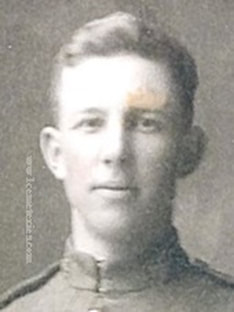
725567 Private
Melvel Northey
21st Bn. Canadian Infantry, (Eastern Ontario Regiment)
Between 9th November 1917 and 12th November 1917, aged 25.
Plot I. A. 20.
Private Melvel Northey 725567 Canadian Expeditionary Forces, Eastern Ontario Regiment, 21st Battalion. Born to Thomas Northey and Martha Jane Fortune on 26 March 1892 in Parry Sound, Ontario, Canada. Married Margaret Anderson Moyes, originally from Tayport, Scotland, in Kinmount, ON., on 25 March 1914. He enlisted in Bobcaygeon, ON., on 3 January 1916 and was nicknamed "Samson" for his amazing strength, combined with an easygoing disposition. Killed in action at Passchendaele sometime between 9 - 12 November 1917. He left behind his wife and two girls, Helen, 3 and Iva, 1.
Picture and information courtesy of Michele Laing
Melvel Northey
21st Bn. Canadian Infantry, (Eastern Ontario Regiment)
Between 9th November 1917 and 12th November 1917, aged 25.
Plot I. A. 20.
Private Melvel Northey 725567 Canadian Expeditionary Forces, Eastern Ontario Regiment, 21st Battalion. Born to Thomas Northey and Martha Jane Fortune on 26 March 1892 in Parry Sound, Ontario, Canada. Married Margaret Anderson Moyes, originally from Tayport, Scotland, in Kinmount, ON., on 25 March 1914. He enlisted in Bobcaygeon, ON., on 3 January 1916 and was nicknamed "Samson" for his amazing strength, combined with an easygoing disposition. Killed in action at Passchendaele sometime between 9 - 12 November 1917. He left behind his wife and two girls, Helen, 3 and Iva, 1.
Picture and information courtesy of Michele Laing
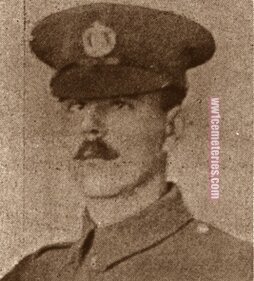
9829 Private
Thomas Henry Palmer
1st Bn. Dorsetshire Regiment
26th April 1915
Plot IV. A. 42.
Lived at 98 Pitcroft Road, Reading, Berks.
Thomas Henry Palmer
1st Bn. Dorsetshire Regiment
26th April 1915
Plot IV. A. 42.
Lived at 98 Pitcroft Road, Reading, Berks.
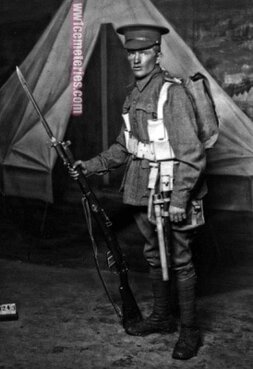
2891 Private
Walter George Smith
5th Australian Pioneers
30th September 1917, aged 20.
Plot III. S. 12.
Ward of Mrs. M. Wensley, of 58, Donald St., Prahran, Victoria, Australia.
From South Yarra, Vic. Pte Smith enlisted on 5 July 1915 and embarked from Melbourne aboard HMAT Star of Victoria on 10 September 1915. On 24 February 1916 he was transferred to the 59th Battalion and on 2 May 1916 he was transferred to the 5th Pioneer Battalion. Pte Smith was killed in action on 30 September 1917.
Walter George Smith
5th Australian Pioneers
30th September 1917, aged 20.
Plot III. S. 12.
Ward of Mrs. M. Wensley, of 58, Donald St., Prahran, Victoria, Australia.
From South Yarra, Vic. Pte Smith enlisted on 5 July 1915 and embarked from Melbourne aboard HMAT Star of Victoria on 10 September 1915. On 24 February 1916 he was transferred to the 59th Battalion and on 2 May 1916 he was transferred to the 5th Pioneer Battalion. Pte Smith was killed in action on 30 September 1917.
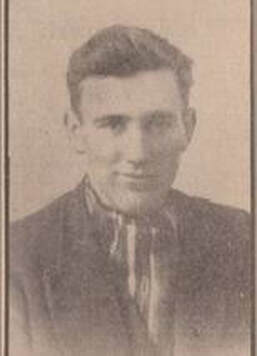
778817 Private
David Strachan
56 Medium Regiment, Royal Artillery
22nd May 1940, aged 26.
Plot I. L. 7.
Son of James and Maggie Strachan, of Fraserburgh, Aberdeenshire; husband of Elizabeth Mary Strachan, of Fraserburgh.
David Strachan
56 Medium Regiment, Royal Artillery
22nd May 1940, aged 26.
Plot I. L. 7.
Son of James and Maggie Strachan, of Fraserburgh, Aberdeenshire; husband of Elizabeth Mary Strachan, of Fraserburgh.
Shot at Dawn
779 Private Herbert H. Chase, 2nd Bn. Lancashire Fusiliers, executed for cowardice 12th June 1915, aged 21. Plot III. P. 1.
A Regular soldier, he landed in France on 22 Aug 1914. On 26 Aug during the rearguard action at Le Cateau, Chase deserted & was at large till recapture in Oct 1914; but he escaped, to be re-arrested in December. On charges of absence without leave, & escaping, he received a sentence of 3 years’ imprisonment (later reduced to 2 years). Following release on 6 May 1915, under the new Suspension of Sentences Act, from the military prison at Rouen, Chase was in action within 2 weeks in the Ypres Salient.
Evidence was given at trial that in the evening of 23 May, he had spoken to another Private of feeling unwell; & that on the following morning he had been asleep in his trench when awoken at 0300, had been found missing at 0400, & had been seen dazed & exhausted by the side of the road to Vlamertinghe at 0430.
In a written statement, Chase said that he had been compelled to leave the trench because of enemy gas; & further, stated on oath that he recalled being awoken, but nothing else till he found himself in hospital.
Following conviction & sentence of death, some statements of further evidence that tended to undermine Chase’s account of illness were — quite irregularly — attached to the paperwork of the proceedings that was reviewed thereafter. The Brigade commander wished an example be made; the Corps commander doubted the strength of evidence; while the Army commander was against commutation once Chase’s previous absence was disclosed to him. (Corns, pp.180-183, 211)
L/8107 Private Alfred E. Eveleigh, 1st Bn. The Buffs (East Kent Regiment), executed for desertion 24th February 1916, aged 27. Plot III. L. 10.
He had enlisted in 1905 at the age of 17,& had served in South Africa; & was already subject to a suspended sentence of death for desertion. (Putkowski, pp.63-64)
L/10098 Private Robert Gawler, 1st Bn. The Buffs (East Kent Regiment), executed for desertion 24th February 1916, aged 29. Plot III. L. 9. Son of Mr. and Mrs. Gawler, of 10, Staplegate Place, Canterbury. Son of Mr. and Mrs. Gawler, of 10, Staplegate Place, Canterbury.
He was convicted of desertion, for which 3 months’ imprisonment with hard labour was imposed; but the sentence was commuted to Field Punishment No l, Gawler thus remaining with his battalion. However he deserted twice more. At trial he was unrepresented, & in the end executed, despite a recommendation at review that his death sentence be commuted on the grounds of his medical & family history. (Putkowski, p. 64)
7171 Private William J. Turpie, 2nd Bn. East Surrey Regiment, executed for desertion 1st July 1915, aged 24. Plot II. C. 24.
A volunteer, he went missing when his battalion was serving in the Ypres Salient. Turpie made his way to Boulogne; managed to obtain a pass from the British Consulate; changed into civilian clothes during the Channel crossing, throwing his uniform overboard; & at Dover took up residence at the Seamen’s Rest Hostel. However he was arrested by the police a few days later at Dover Priory Railway Station, giving his correct name & address, but spinning an elaborate yarn of being a fireman on shipboard. In due course, he admitted being a deserter; & was returned to Flanders for trial — where he could not recall much detail of the circumstances, but said that he had been infected with lice & sores, & had been receiving medication for dysentery. He does not seem to have been given any medical examination, the court showing him no sympathy. (Putkowski, pp. 45-46)
Pictures of headstones below © Geerhard Joos
779 Private Herbert H. Chase, 2nd Bn. Lancashire Fusiliers, executed for cowardice 12th June 1915, aged 21. Plot III. P. 1.
A Regular soldier, he landed in France on 22 Aug 1914. On 26 Aug during the rearguard action at Le Cateau, Chase deserted & was at large till recapture in Oct 1914; but he escaped, to be re-arrested in December. On charges of absence without leave, & escaping, he received a sentence of 3 years’ imprisonment (later reduced to 2 years). Following release on 6 May 1915, under the new Suspension of Sentences Act, from the military prison at Rouen, Chase was in action within 2 weeks in the Ypres Salient.
Evidence was given at trial that in the evening of 23 May, he had spoken to another Private of feeling unwell; & that on the following morning he had been asleep in his trench when awoken at 0300, had been found missing at 0400, & had been seen dazed & exhausted by the side of the road to Vlamertinghe at 0430.
In a written statement, Chase said that he had been compelled to leave the trench because of enemy gas; & further, stated on oath that he recalled being awoken, but nothing else till he found himself in hospital.
Following conviction & sentence of death, some statements of further evidence that tended to undermine Chase’s account of illness were — quite irregularly — attached to the paperwork of the proceedings that was reviewed thereafter. The Brigade commander wished an example be made; the Corps commander doubted the strength of evidence; while the Army commander was against commutation once Chase’s previous absence was disclosed to him. (Corns, pp.180-183, 211)
L/8107 Private Alfred E. Eveleigh, 1st Bn. The Buffs (East Kent Regiment), executed for desertion 24th February 1916, aged 27. Plot III. L. 10.
He had enlisted in 1905 at the age of 17,& had served in South Africa; & was already subject to a suspended sentence of death for desertion. (Putkowski, pp.63-64)
L/10098 Private Robert Gawler, 1st Bn. The Buffs (East Kent Regiment), executed for desertion 24th February 1916, aged 29. Plot III. L. 9. Son of Mr. and Mrs. Gawler, of 10, Staplegate Place, Canterbury. Son of Mr. and Mrs. Gawler, of 10, Staplegate Place, Canterbury.
He was convicted of desertion, for which 3 months’ imprisonment with hard labour was imposed; but the sentence was commuted to Field Punishment No l, Gawler thus remaining with his battalion. However he deserted twice more. At trial he was unrepresented, & in the end executed, despite a recommendation at review that his death sentence be commuted on the grounds of his medical & family history. (Putkowski, p. 64)
7171 Private William J. Turpie, 2nd Bn. East Surrey Regiment, executed for desertion 1st July 1915, aged 24. Plot II. C. 24.
A volunteer, he went missing when his battalion was serving in the Ypres Salient. Turpie made his way to Boulogne; managed to obtain a pass from the British Consulate; changed into civilian clothes during the Channel crossing, throwing his uniform overboard; & at Dover took up residence at the Seamen’s Rest Hostel. However he was arrested by the police a few days later at Dover Priory Railway Station, giving his correct name & address, but spinning an elaborate yarn of being a fireman on shipboard. In due course, he admitted being a deserter; & was returned to Flanders for trial — where he could not recall much detail of the circumstances, but said that he had been infected with lice & sores, & had been receiving medication for dysentery. He does not seem to have been given any medical examination, the court showing him no sympathy. (Putkowski, pp. 45-46)
Pictures of headstones below © Geerhard Joos


